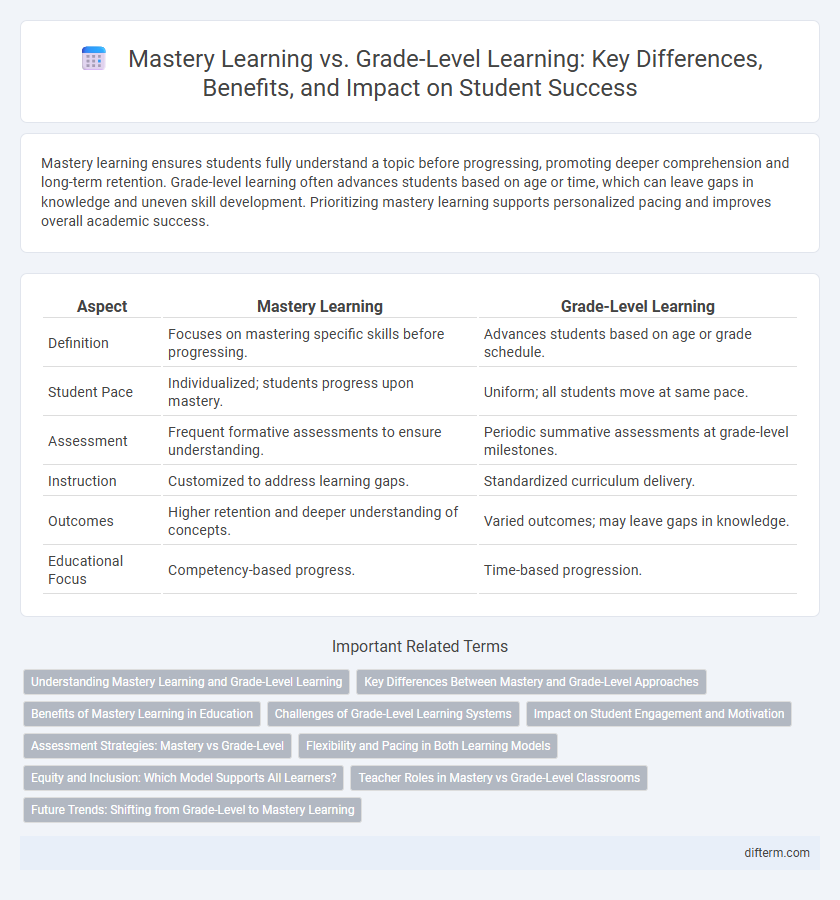Mastery learning ensures students fully understand a topic before progressing, promoting deeper comprehension and long-term retention. Grade-level learning often advances students based on age or time, which can leave gaps in knowledge and uneven skill development. Prioritizing mastery learning supports personalized pacing and improves overall academic success.
Table of Comparison
| Aspect | Mastery Learning | Grade-Level Learning |
|---|---|---|
| Definition | Focuses on mastering specific skills before progressing. | Advances students based on age or grade schedule. |
| Student Pace | Individualized; students progress upon mastery. | Uniform; all students move at same pace. |
| Assessment | Frequent formative assessments to ensure understanding. | Periodic summative assessments at grade-level milestones. |
| Instruction | Customized to address learning gaps. | Standardized curriculum delivery. |
| Outcomes | Higher retention and deeper understanding of concepts. | Varied outcomes; may leave gaps in knowledge. |
| Educational Focus | Competency-based progress. | Time-based progression. |
Understanding Mastery Learning and Grade-Level Learning
Mastery learning emphasizes students achieving a high level of understanding in a specific topic before progressing, ensuring foundational skills are solidified. Grade-level learning follows a fixed curriculum schedule where all students move through content at the same pace, regardless of individual comprehension. Research indicates mastery learning can improve retention and allow personalized pacing, while grade-level learning supports standardized assessment benchmarks.
Key Differences Between Mastery and Grade-Level Approaches
Mastery learning emphasizes achieving a high level of understanding in a topic before advancing, ensuring students grasp foundational concepts deeply. Grade-level learning progresses students through curriculum units based on age or school year, often maintaining pace over individual comprehension. This approach may lead to gaps in knowledge when students move forward without mastering prior material.
Benefits of Mastery Learning in Education
Mastery learning ensures students achieve a deep understanding of each concept before advancing, significantly improving long-term retention and academic performance. Personalized pacing allows learners to progress according to their individual needs, reducing frustration and increasing motivation. Research indicates mastery learning narrows achievement gaps by providing targeted support, fostering equity in education.
Challenges of Grade-Level Learning Systems
Grade-level learning systems often fail to address individual student needs, leading to gaps in understanding and decreased motivation. This rigid structure assumes uniform learning pace, neglecting diverse cognitive development and causing some students to fall behind. Consequently, educators struggle to provide personalized support within standardized curricula, limiting overall academic achievement.
Impact on Student Engagement and Motivation
Mastery learning significantly enhances student engagement by allowing learners to progress only when they demonstrate understanding, fostering a sense of accomplishment and motivation. In contrast, grade-level learning often advances students at a uniform pace regardless of comprehension, which can lead to frustration or disengagement for those struggling to keep up. Research indicates that mastery-based approaches increase intrinsic motivation by promoting personalized feedback and growth mindsets, ultimately improving academic outcomes.
Assessment Strategies: Mastery vs Grade-Level
Mastery learning assessment strategies emphasize continuous evaluation through formative assessments, ensuring students achieve a deep understanding before progressing. In contrast, grade-level assessment relies on summative tests that measure proficiency based on age or grade benchmarks, often advancing students regardless of mastery. Data-driven feedback in mastery learning supports personalized instruction tailored to individual readiness, whereas grade-level assessments prioritize standardization and comparability across cohorts.
Flexibility and Pacing in Both Learning Models
Mastery learning emphasizes personalized pacing, allowing students to progress only after demonstrating a thorough understanding of each concept, thus enhancing flexibility in the learning process. In contrast, grade-level learning follows a fixed schedule aligned with curriculum standards, often requiring all students to move forward simultaneously regardless of individual comprehension. This rigid pacing can limit adaptability, potentially hindering students who need additional time or acceleration to achieve academic success.
Equity and Inclusion: Which Model Supports All Learners?
Mastery learning promotes equity and inclusion by allowing students to progress at their own pace, ensuring comprehension before advancing, which reduces achievement gaps and supports diverse learning needs. Grade-level learning often adheres to rigid timelines that may leave struggling students behind, perpetuating inequities. Personalized pacing and targeted feedback in mastery learning create a more inclusive environment that supports all learners effectively.
Teacher Roles in Mastery vs Grade-Level Classrooms
Teachers in mastery learning classrooms act as facilitators who provide personalized support, ensuring each student achieves competence before advancing. In grade-level classrooms, teachers primarily deliver standardized content aimed at covering curriculum within set time frames, often leading to varied student comprehension. Mastery learning teachers frequently utilize formative assessments to identify learning gaps and tailor instruction accordingly, contrasting with the summative assessment focus typical in grade-level settings.
Future Trends: Shifting from Grade-Level to Mastery Learning
Future trends in education highlight a significant shift from traditional grade-level learning to mastery learning models, emphasizing personalized pacing and competency-based progression. Mastery learning fosters deeper understanding by ensuring students achieve proficiency in each concept before advancing, which enhances long-term retention and skill development. This approach aligns with evolving educational technologies and data analytics that support adaptive learning environments tailored to individual student needs.
mastery learning vs grade-level learning Infographic

 difterm.com
difterm.com